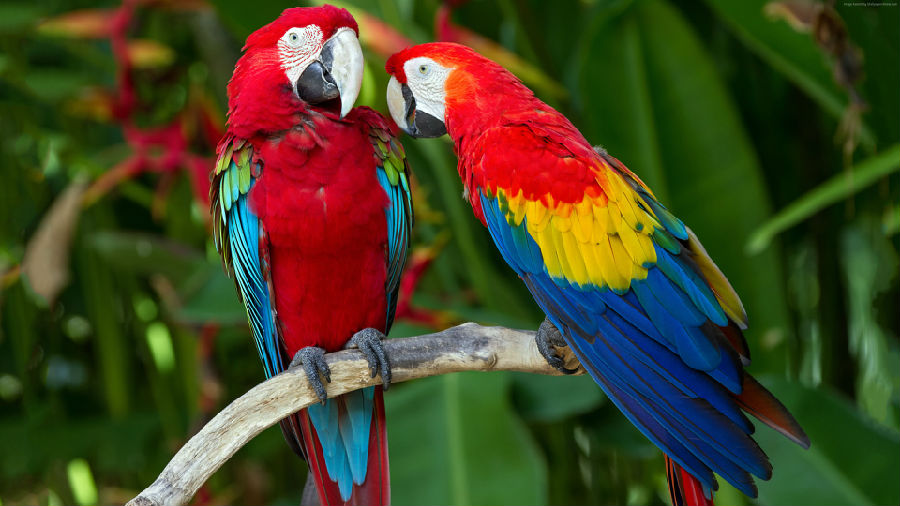This is what a macaque monkey would sound like if it suddenly proposed.
猕猴要是突然求起婚来,他的声音应该会是这样。
Yeah, I hate it too.
嗯,我也不喜欢。
Let’s play it again:
让我们再听一遍:
Now of course, that’s not a real monkey,
当然了,这个声音并不是真猴子发出来的,
it’s a computer simulation that was part of a study on monkey vocal tracts.
而是科学家们在对猴子声道进行研究的过程中通过计算机模拟出来的。
And what it shows is that monkeys have a strikingly similar vocal structure to humans.
研究结果表明,猴子和人类的发声系统有着惊人的相似之处。
But despite all these similarities, they can’t speak.
然而,尽管如此,猴子还是不会说人话。
So here’s a question.
那么问题来了。
Compared to monkeys, birds are nothing like us.
与猴子相比,鸟类可以说和人类毫无共同之处。
Yet this bird’s talking to me right now. How?
但是,此时此刻,这只鸟却能对我说话。这是为什么?
Birds don’t have lips,
鸟类没有嘴唇,
they don’t have teeth, their “nose” is totally different from ours,
也没有牙齿,它们的“鼻子”也和我们的完全不同,
but they do have something we don’t.
但它们也有我们人类没有的东西。
"They actually have a different kind of voice box than we do.
“其实,鸟类有着和我们人类不一样的声匣。
It's called a syrinx."
它们的声匣叫“鸣管”。
This is Mya Thompson, she studies birds at Cornell University.
这位是美雅·汤普森,她是康奈尔大学的鸟类研究员。
"They actually have two independent voice boxes."
“它们有两个独立的声匣。”
In birds, and in humans, the lower respiratory system is shaped sort of like an upside down slingshot.
鸟类的下呼吸系统的形状有点像一个倒置的弹弓,人类也是一样。
The top part is the trachea, or windpipe, the bottom part is the lungs, and these two pieces move air in and out.
上面的部分是气管,下面的部分是肺,这两个部分负责空气的呼出与吸入。
In humans, the voice box is called the larynx, and it’s located above the trachea.
人类的声匣即“咽喉”,位于气管上方。
It contains vocal “folds” that vibrate when air flows through to produce sound.
咽喉处有发声的“褶皱”,空气经过时就会发生振动,进而发出声音。
And humans primarily shape that sound with their mouths.
人类主要用嘴来塑造这一声音。
But in birds, the voice box is called the "syrinx".
但鸟类的声匣叫“鸣管”。
And it’s at the bottom of the trachea.
位于气管的下方。
Instead of just sending air through vocal folds like we do,
鸟类实际上是通过控制鸣管壁上的肌肉来塑造和发出声音的,
birds actually control the muscles on the walls of the syrinx to shape and produce sound.
而不是像我们一样要让空气穿过声带。
Take a look at this cardinal as it sings.
就拿这只北美红雀唱歌的样子来说,
You can actually see that the noise comes directly from the chest.
可以看到,它们的声音是直接发自胸腔的。
The bird extends and shortens its neck and opens or closes its beak to refine the noise,
这只鸟是通过伸长和缩短它的脖子,张开或闭上它的嘴来改进它发出的声音的,
but most of the control is actually happening in the syrinx.
但它主要还是靠鸣管在控制声音。
It’s a powerful sound for such a small animal,
对于这么小的动物来说,能发出这样的声音已经很了不起了,
but that’s not even the most impressive part:
但这还不是最厉害的:
Cardinals tend to make these "whoop" notes and they go by very very quickly.
北美红雀习惯发出这种“欢呼”似的声音,而且叫声非常短促。

They're able to produce more pitches than a piano in less than a tenth of a second.
不到十分之一秒的时间里,它们能切换出的音高比一台钢琴能切换的都多。
They're actually switching from one side of the syrinx to another seamlessly to make this very very incredible span of pitches.
他们能够从鸣管的一边无缝地切换到另一边,从而让发出的音高的跨度变得极其的不可思议。
The syrinx also lets some birds replicate sounds with astonishing accuracy.
鸟类的鸣管还能让一些鸟类以惊人的精确度重复某些声音。
For example, BBC Wildlife caught a lyrebird perfectly imitating a camera in the wild.
例如,BBC野生动物频道就曾捕捉到一只琴鸟在野外完美地模仿照相机发出的声音。
And of course, some of them imitate us.
当然,还有一些甚至能模仿我们的声音。
Parrots are born communicators.
鹦鹉天生就能沟通。
From the start their brains are wired for speech.
首先,它们的大脑结构就为语言提供了基础。
So when they're first hatched they're learning right away and they're learning from everything around them.
小鹦鹉刚一孵出来就会开始学习,学习周围环境的一切。
But speaking human is no easy feat.
但说人话也并非易事。
We’ve got our vowels A - E - I - O - U.
我们有A,E, I ,O,U这些元音。
Our plosives “Pocket”.
有“口袋”这种爆破音。
And a variety of consonants – that we even sometimes struggle to enunciate clearly.
还有各种有时我们自己都难以清晰发出的辅音。
So to pull off such clarity in human speech,
所以要能在模仿人类语言时达到如此清晰的地步,
parrots really show off their ability to manipulate their vocal tract.
鹦鹉真的得好好发挥它们操纵声道的能力。
Plosives, for example, require using our lips.
例如,发爆破音时我们需要用到嘴唇。
To make up for the lack of lips, parrots use something called esophageal speech –
鹦鹉则能用一种叫做“食道语言’的东西来弥补没有嘴唇这一缺陷——
it's almost like burping that comes from within the trachea.
这种语言就跟从气管里打嗝差不多。
The force of air replicates the plosive.
让空气的力量来模拟爆破的感觉。
As for vowels, where we use our lips, tongue and jaw,
至于元音,我们会用到嘴唇、舌头和下颚,
researchers have found that parrots move their tongues forward and backward and adjust their beak opening to alter the sound.
研究人员发现,鹦鹉会通过前后移动舌头,调整嘴的开口来改变声音,从而发出类似元音的声音。
And it seems like they are the only birds that are actually using their tongue like humans do to shape the sound that's coming out.
而且,鹦鹉似乎也是唯一一种会像人类一样用舌头来塑造发出的声音的鸟类。
Parrots have a natural desire to communicate.
鹦鹉天生就有交流的欲望。
In the wild they form strong bonds with their flocks,
在野外,它们会和同伴形成非常紧密的联系,
but in captivity, the parrot forms a social bond with you
被人类饲养之后,它们也会和人类建立一种社会关系
and they want to communicate with you and they have the vocal anatomy to start mimicking you.
它们想和你交流,它们的声音结构也有模仿你的条件。
When parrots live with us, we’re their flock and they’re determined to sing our song.
和我们生活在一起,我们就是它们的同伴,所以,它们便会开始唱我们的歌。












